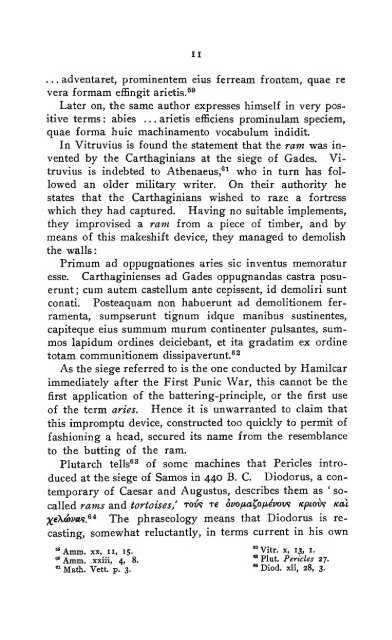Figurative uses of animal names in Latin and their ... - mura di tutti
Figurative uses of animal names in Latin and their ... - mura di tutti
Figurative uses of animal names in Latin and their ... - mura di tutti
Create successful ePaper yourself
Turn your PDF publications into a flip-book with our unique Google optimized e-Paper software.
II<br />
. . . adventaret, prom<strong>in</strong>entem eius ferream frontem, quae re<br />
vera formam eff<strong>in</strong>git arietis.^®<br />
Later on, the same author expresses himself <strong>in</strong> very pos-<br />
itive terms : abies . . . arietis eflficiens prom<strong>in</strong>ulam speciem,<br />
quae forma huic mach<strong>in</strong>amento vocabulum <strong>in</strong><strong>di</strong><strong>di</strong>t.<br />
In Vitruvius is found the statement that the ram was <strong>in</strong>-<br />
vented by the Carthag<strong>in</strong>ians at the siege <strong>of</strong> Gades. Vi-<br />
truvius is <strong>in</strong>debted to Athenaeus,®^ who <strong>in</strong> turn has followed<br />
an older military writer. On <strong>their</strong> authority he<br />
states that the Carthag<strong>in</strong>ians wished to raze a fortress<br />
which they had captured. Hav<strong>in</strong>g no suitable implements,<br />
they improvised a ram from a piece <strong>of</strong> timber, <strong>and</strong> by<br />
means <strong>of</strong> this makeshift device, they managed to demolish<br />
the walls:<br />
Primum ad oppugnationes aries sic <strong>in</strong>ventus memoratur<br />
esse. Carthag<strong>in</strong>ienses ad Gades oppugn<strong>and</strong>as castra posu-<br />
erunt; cum autem castellum ante cepissent, id demoliri sunt<br />
conati. Posteaquam non habuerunt ad demolitionem fer-<br />
ramenta, sumpserunt tignum idque manibus sust<strong>in</strong>entes,<br />
capiteque eius summum murum cont<strong>in</strong>enter pulsantes, summos<br />
lapidum ord<strong>in</strong>es deiciebant, et ita gradatim ex ord<strong>in</strong>e<br />
totam communitionem <strong>di</strong>ssipaverunt.®^<br />
As the siege referred to is the one conducted by Hamilcar<br />
imme<strong>di</strong>ately after the First Punic War, this cannot be the<br />
first application <strong>of</strong> the batter<strong>in</strong>g-pr<strong>in</strong>ciple, or the first use<br />
<strong>of</strong> the term aries. Hence it is unwarranted to claim that<br />
this impromptu device, constructed too quickly to permit <strong>of</strong><br />
fashion<strong>in</strong>g a head, secured its name from the resemblance<br />
to the butt<strong>in</strong>g <strong>of</strong> the ram.<br />
Plutarch tells^* <strong>of</strong> some mach<strong>in</strong>es that Pericles <strong>in</strong>troduced<br />
at the siege <strong>of</strong> Samos <strong>in</strong> 440 B. C. Diodorus, a contemporary<br />
<strong>of</strong> Caesar <strong>and</strong> Augustus, describes them as ' so-<br />
called rams <strong>and</strong> tortoises,' tow re ovoiia^<strong>of</strong>ievow Kpioix; Kal<br />
^€\o)va



![Das Kriegswesen der Alten [microform] - mura di tutti](https://img.yumpu.com/21606999/1/167x260/das-kriegswesen-der-alten-microform-mura-di-tutti.jpg?quality=85)








